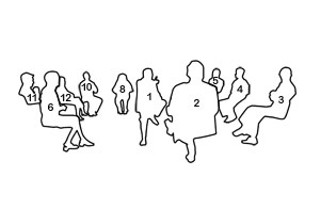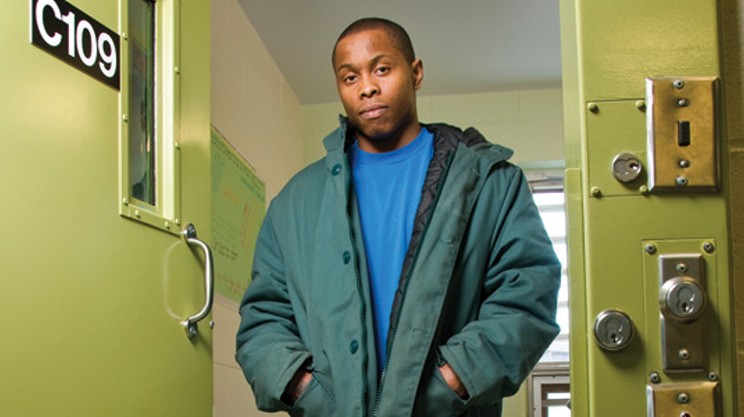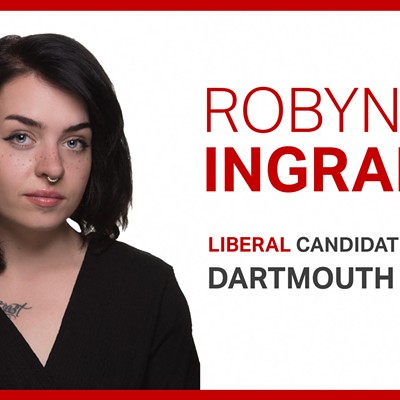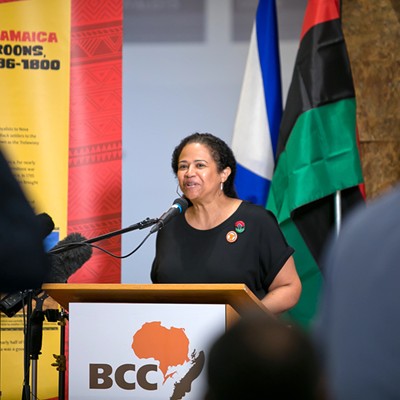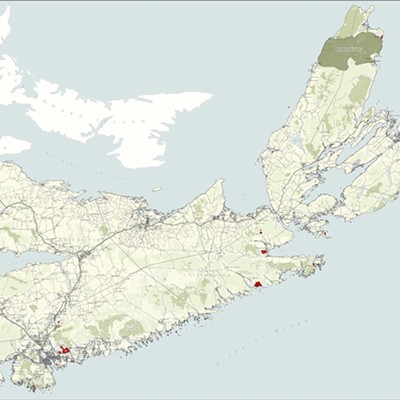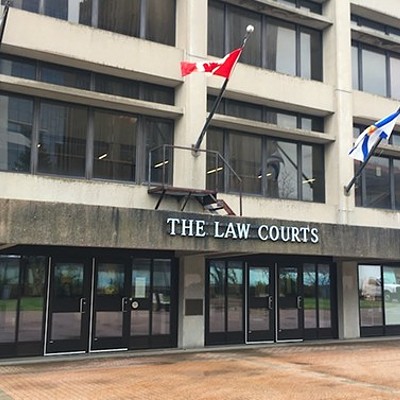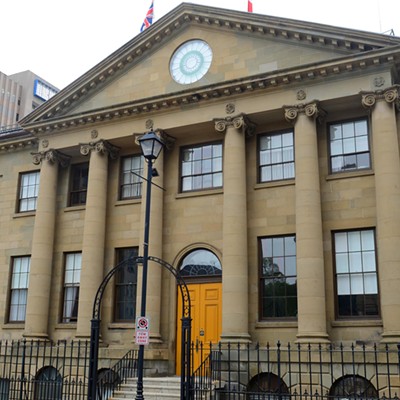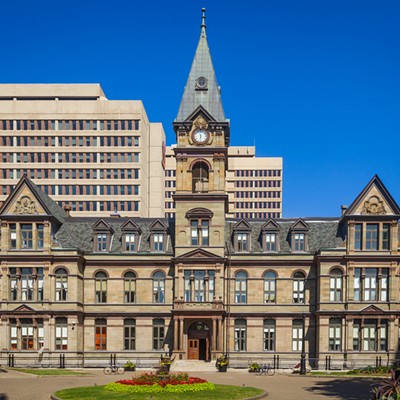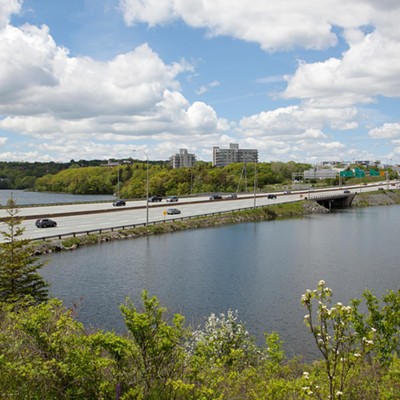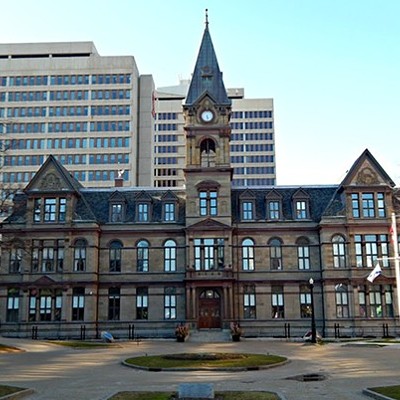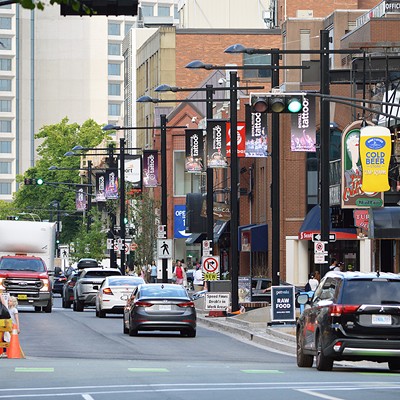
The Coast - CBC TV Violence Task Force in studio. Photos by Aaron Fraser.
The Violence Task Force is the first of a series of joint productions of The Coast and CBC TV leading up to the October 18 municipal election in Halifax. The joint productions will examine a series of local issues, including violence, transit and the mayoral race itself.
The members of the Violence Task Force met for an hour last Thursday morning in the CBC studio on Bell Road. CBC will air short segments of the meeting on CBC News: Nova Scotia at Six this week, and will post the entire hour at cbc.ca/cbcns. The Coast has posted a complete transcript and an audio recording of the meeting at thecoast.ca. The following is an abridged transcript of meeting highlights, transcribed by Tim Bousquet.
Nunn: There was a swarming on the Halifax Common. There was a person killed on the sidewalk downtown. There has been incident after incident of violent activity in Halifax.... Let's start downtown, Chris. Can you give us an indication of how bad the situation is, if indeed it's that bad?
Murphy: We had a situation in which there were a variety of problems. The first one that got a lot of attention was a lot of public disorder, late night drunkenness, assaults---some of them quite violent, some of them fairly benign. There was a sense that this was a situation growing out of control and that we needed---as a community, as a city---to do something about both the causes and to enhance public safety downtown.
Nunn: Halifax got a bit of a reputation as a tough town.
Murphy: It's always been a bit of a tough town, being a port city. But I think in the last three or four years, these very public incidents, including knifings in the streets and murders, began to create a reputation for Halifax that we were increasingly uncomfortable with.
Nunn : How did you let the situation get out of control?
Zima: The downtown core itself has over 200 licenced liquor establishments and, as it has been described in the Clairmont report, it really has created the perfect storm for violence in the downtown area: You have cheap drinks, very large cabarets bars open until four o'clock in the morning populated by an abundance of young people that are highly intoxicated.
Syperek: I don't think the bars are the problem. I think it's kids hanging out on the Common swarming people, drugs. I don't think there's a drinking problem at all.
Zima: Well, certainly, kids hanging around at the Common has nothing to do with the crime we see at the downtown bar scene. They're two separate issues altogether.
Syperek: Most of the problems downtown tend to be about either men and women fighting over each other. The big brawl at Christmas was about a drug turf war; it had nothing to do with drinks. The brawl happened because the bouncers kicked everybody out just like that and so had to leave without their coats, and so you get 400 maybe slightly intoxicated people outside without their coats pissed off and they started fighting each other.
Levett: I think there's a bigger picture here, which comes down to the judicial system. Youths get off of crime really easily. There's a slap on the wrist and no system of accountability, and they're right back in the community. A lot of times if there's people that are swarmed in the Common or a disturbance at Pizza Corner---it's youth crime. It's not necessarily people who come out from these nightclubs or bars looking for trouble. The two come together, but it comes back to the decisions made by the judicial system.
MacIsaac: At the community justice side, we've found that there's a web of root causes that disengage youth from school: Not having enough pro-social activities community isolation. There are so many things that go into creating these young criminals, and it takes a web of support to get them out. The Youth Criminal Justice Act works really well for about 80 percent of the youth that are charged. But there's this 15 to 20 percent that falls through the cracks and the justice system tends to be a catch-all for all of these youth who are disengaged from school, who fall through mental health issues, group home youth, we've dropped the ball as a community.
Nunn: I want to take this back downtown. People get hurt on the sidewalks outside of bars. What should we do about that?
Levett: I don't know that you're ever going to change it. There's always going to be fights, there's always going to be arguments. That'll come down to individual security staffs within a licenced establishment.
Gault: I disagree that there's nothing we can do to make the downtown safer. One thing that is really important is transportation. We need to be able to get to and from the downtown safely...hopefully, we're going to see a late-night bus.
Murphy: We've found there's a very clear relationship between cheap drinks, late nights and over-serving of young people. There are ways to manage and limit the over-consumption of alcohol and reduce a lot of the problems that result. We have to keep in mind that what we're talking about downtown is a very separate and distinct problem from swarmings in the Common or drug-related crimes on the streets.
Syperek: I'm not an advocate of cheap drinks and don't serve them, because there's no point in them. You make your money on the cover and you end up with a lot of drunks who are a nuisance. I find the jovial drinking crowd actually a joy to be with, and I personally don't have a lot of problems downtown. We have had incidents, especially when we were a cabaret, late night, and I got rid of the licence because it was a hassle---then you tend to get everybody else's drunks.
Nunn : Are you afraid to be downtown?

Facing camera: Victor Syperek, ower of The Economy Shoe Shop ad Tara Gault, executive director of the Halifax Student Alliance.
Gault: Under certain circumstances, yes. And it's students that are being targeted. It's that age group between 21 and 25 who are most vulnerable, who are being victims of these crimes.
Nunn: It's young women you're talking about?
Gault: Absolutely.
Fairfax: I've never understood, where young women are concerned, where they get it in their head walk home to the south end in a pretty little miniskirt at two in the morning...it's hard to get a cab, so they walk.
Syperek: In the rain storm two weeks ago, there was an average one-hour wait for a cab.
Lalancette: In some cities I've been in---I was 25 years in the Navy---after 11 o'clock, the taxi stands become the only place where you can pick up customers. You're not allowed to pick up flag people, which protects the driver because there's a whole lineup of people who see who's getting in the taxi, and it protects the customer because they're all together in the same place. These are supervised taxi stands.
Murphy: It should be straight-forward. The city can do it tomorrow, if it wants to, and if they're serious about responding to this report, they should do that. I wanted to add one thing about bars---there's a difference between bars and the kinds of levels of violence that takes place. Where the riot took place, it had a licence for over 1,000 people. That's not a good formula---it's way too big, and too impersonal, and there's all kinds of things about the ways service is done and how it's set up. Smaller neighbourhood bars with a clientele where they're known cause far fewer problems.
Zima: Absolutely. The smaller bars that are more personal in nature and where the bar staff gets a chance to monitor their clientele throughout the night, as Victor says, you have people come into your bar that you know, they come in on a regular basis, so you don't have the impersonal and large groups where they are unsupervised.
Levett: I agree that in a bar where there's 1,000 or 2,000 people there's greater chances of something occurring, but it's the atmosphere, in most of those places, you know?
Jones: You should be talking about responsible drinking. There's a certain mentality of people that want to go downtown and get that drunk and be in a fight. I run an event and have youth in it who are 18 to 25, and some people are drinking, you have people from all different areas, and we have no security, I have no problems. We're doing rap battles, and people are arguing back and forth, and there are no fights. The environment that we have there is you have to respect that environment if you're going to come there, and that's how people treat it. It's the mindset of the clientele you're trying to attract.
Nunn: Apparently, crime is down in Canada. Is crime down in Halifax?
Murphy: Violent crime is actually only moderately down, and it was pretty high before. Property crime has the biggest decline.
Nunn: The Clairmont report says that victims of crimes in this city tend to be black. Does Halifax have a crime problem or a race problem?
Jones: Both. It definitely has a race problem. This is a pretty racist province, and that's not going away. So when police officers are tending to crimes in black neighbourhoods, they have their own stereotypes that they're taking with them, and that's going to affect how they pursue the crime.
Murphy: Police don't create these crimes. I think there are some real issues that the police can play a role in addressing, but there are some real fundamental problems about income, employment, community, the integrity of communities, culture---these are more diffuse and harder to get at. While I think racism is an issue, we just can't paint this complicated picture with that one rather simplistic assessment.
Nunn: What do you see as the most effective way to bring crime in the black community down?
Fairfax: I think it has to start with some sort of an education, especially for the young black parents. A lot of them are young, black single mothers, and they're not educated. It would be really nice to see them get some sort of an education, so that they're able to provide for their children, and their children are able to have a positive role model to look up to. That's not prevalent in the black community.
MacIsaac: One thing that we've identified is a real disconnect of cultural identity. In response to that, black youth learning about their culture from BET or learning about their culture from entertainment---CDs they listen to, magazines...There are so many positive role models in our communities that young people never get to see because they are so enamoured with gang violence, they're so enamoured with making easy money. There is a lack of role models, mentoring, positive engagement with people they can identify with and connect with. More youth drop-in centres, more places like the rap battles where people are culturally expressing themselves---I think those are great. We need more of those.
Nunn : You live in the Square, don't you? As long as I've lived in Halifax, that's been identified as the centre of trouble.
Verny: I feel safer walking through Uniacke Square than I did Fairview when I lived there, and I grew up in Fairview. In our community, there are a handful of people who are making it look bad for the overall community.
Jones: I feel safer in the Square than I do in downtown Halifax, especially if there's a hockey game going on or if it's St. Patrick's Day and you've got all these drunks running around the streets---I'd much rather be in the Square, because it's safer, because this is a racist town. People are scared to go into the black neighbourhoods, but for me, it's the safest place to go. I'm scared to go into the south end after dark. It's a race thing.
Murphy: There's a lack of adequate programs in certain areas, for instance, drug rehabilitation. There are lots of people addicted to drugs who cannot get into programs, and they're going to maintain their habit and it's directly related to crime. We need to be looking at community supports, family supports, recreational alternatives---these are the kinds of answers that will bring some kind of improvement.
Nunn: But when you think of eight or 10 young women swarming an older woman on the Common, what kind of intervention is going to change that activity?
Zima: Those crimes are particularly violent, they're very unpredictable and they're very difficult to get a handle on because they're what we call "signal crimes."
Murphy: If you look at the background of those eight, I guarantee you'd find a history of dysfunctional family, parenting, etc. They're unpredictable, but they're predictable.
Nunn: What is a signal crime?
Zima: It's particularly gratuitous violence for no apparent reason against particularly innocent victims.
MacIsaac: With the signal crimes, you'll find that teachers saw that happening way before the police saw it. And with restorative justice, we've probably seen all of these kids when they were 12 and 13 and sent them back to the Crown, back to the court, and said, "These are not appropriate for our program, they need more intervention." But where does that information go? There's a real breakdown. No one shares information with each other. Educators are seeing these problems in grade two and they can't say anything until grade eight when the police get involved.
Bower: There are options out there. Within the Halifax Youth Attendance Centre you have disciplines from health, education, justice, community services all working under one roof provides programming to actually meet their needs. So every youth that walks through, they have an assessment done, if they need access to career counseling or education, mental health services addiction services, they're provided with those services.
Nunn: These are kids that have been in trouble with the law, or not?
Bower: All the youth that attend the Halifax Youth Attendance Centre are on court order.
Syperek: Just a question to the police: When you hear a media report about "This happened outside of well-known crack house," how can everybody know about a crack house and nothing's done about it?
Zima: We're doing things about . But it takes a lot of intelligence information. You can't just go to a judge and say, "I think there's a crack house here, I need a search warrant." We are conducting searches under the Controlled Drug and Substances Act on a daily basis.
Murphy: Relative to that point, what do the courts do with the charges when you make them? We've found that there's a lack of consistency between what the public expects, what the police have laid charges for and what is considered an appropriate response.
Nunn: So you think the courts are letting them walk?
Murphy: And in many cases they are. And in part because of the limits that the law places on their sentencing ability and also a positive approach---assuming there will be community options and alternatives for them which will make an impact...on them. Judges have the capacity to make sentences now---we don't need to change the criminal code. But they have a variety of objectives they have to meet.
Verny: Why do we have to wait for these kids to go out and commit a crime before we can get them the help that she offers? My daughter---when she was about eight, nine years old, she was angry and stuff. So I said, there's something wrong. So I phoned SOS workers. I phoned Children's Aid, I phoned my social worker and all these different places. One woman from Corrections Canada literally told me that my daughter had to go out and commit a violent crime and hope that the judge ordered her to take anger management. People need a place to turn, somewhere where they can just talk, where they don't have to worry about that person going back and saying, "Well, I think she's dysfunctional, let's phone Children's Aid and get her kids removed." Because that's a lot of the impression that people have.
Fairfax: For the last five years or so, there's been in the Halifax Shopping Centre, there's been some sort of a drop-in program for youth, basically junior high and high school students. It's wonderful.
MacIsaac: I run that program.
Fairfax: Do you? I think it's a brilliant idea, and I wonder why we don't have something like this downtown. There was one particular girl, she felt like she was heading the wrong way. I think she was 14 or 15, and she didn't want to go the wrong way. She knew about this centre; it just sounds wonderful.
Nunn: Are we making some progress? Is it possible that we're cleaning up this town?
Murphy: People have realized that there are problems here, and I think there has been a renewed interest in trying to do things, both at the provincial level, the city level, and if we keep this kind of dialogue going, we need to leverage more responses. And the police have done some new things that they weren't doing a couple of years ago in response to these issues. We have turned a corner, and we need to keep putting the pressure on to develop the kinds of responses that we've heard here. We need to keep making politicians aware that we need these kinds of investments in people and communities to make a difference.
Nunn: I have the impression that we're making progress here.
Zima: We're moving in the right direction, and as Chris says, this requires an inter-governmental and a multi-faceted approach to the problem. This is not a Community Services issue. This is not a black community issue. This is not a policing issue. We all have to work together.
If you want to view the whole discussion, you can watch the CBC broadcast on the CBC News: Nova Scotia at Six website.

